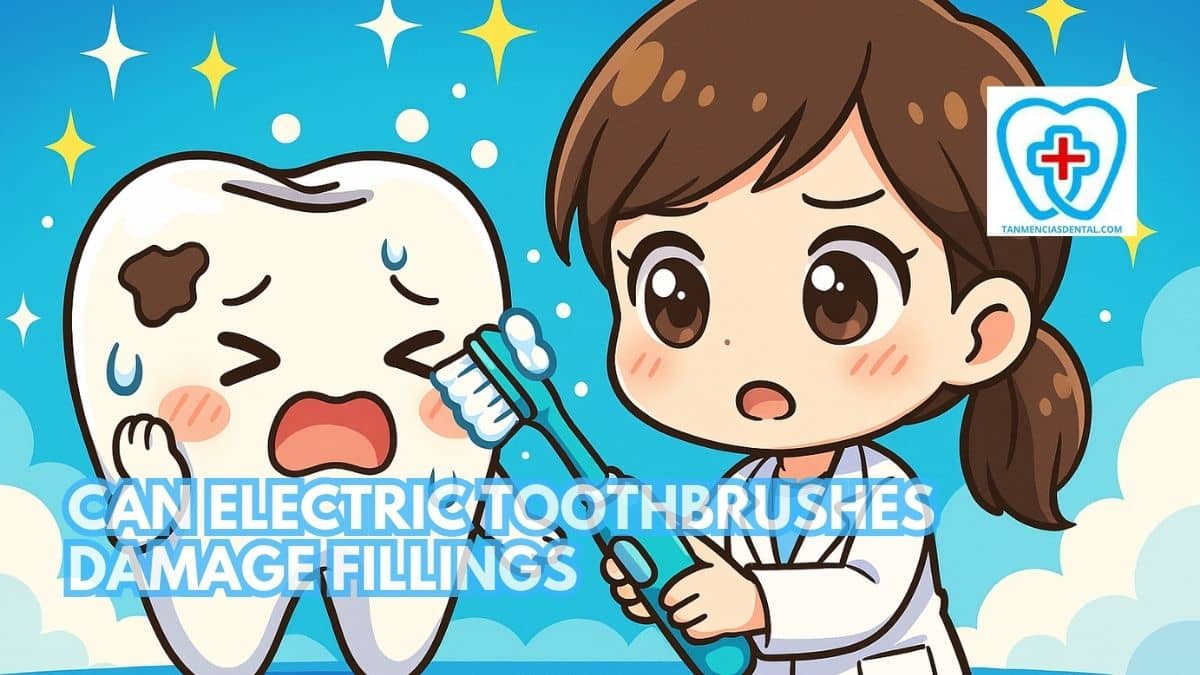Electric toothbrushes are often praised for making daily cleaning easier and more effective than manual brushes.
Many people ask the important question, Can electric toothbrushes damage fillings, since dental work needs extra care.
The answer is that these brushes are safe for fillings when used with the right pressure, brush head, and technique.
Still, understanding how different models work and how to use them properly can make a big difference in keeping fillings secure.
We’ll explain the facts, clear up common concerns, and give practical steps to protect both your teeth and your dental work.
1. Electric Toothbrushes: Brushing Up on the Benefits
Electric toothbrushes offer a range of benefits that enhance oral hygiene.
They are more effective at removing plaque and reducing gingivitis compared to manual toothbrushes.
Features like timers and pressure sensors help ensure users brush for the recommended duration and avoid excessive force.
Additionally, electric toothbrushes are easier to use for individuals with limited mobility, such as those with arthritis.
These advantages make electric toothbrushes a popular choice for achieving a cleaner, healthier smile.
🦷 Brushing BFF or Brushing Blocker? The Truth About Mouthwash Before Brushing Teeth
2. Rotary vs. Sonic: Does Brush Type Matter for Fillings?
Electric toothbrushes come in two main types: rotary and sonic.
Rotary toothbrushes feature rotating heads that spin in a circular motion, while sonic toothbrushes use high-frequency vibrations to clean teeth.
Both types are effective, but some believe that the intense vibrations of sonic brushes could potentially harm fillings.
However, research indicates that both types are safe when used correctly.
Understanding the differences can help you choose the best option for your specific dental needs.
🦷 Why Understanding Dentist Vs Oral Surgeon Roles Matters for Your Oral Health
3. Battery-Powered vs Rechargeable: What It Means for Fillings
Battery-powered toothbrushes often provide weaker and less steady brushing compared to rechargeable models.
Rechargeable brushes typically deliver stronger and more consistent vibrations, which may clean more effectively around teeth and fillings.
The difference in strength and steadiness does not make either type unsafe for fillings when used correctly.
Some people may find rechargeable models more comfortable and easier to control because of their steady power.
Knowing these differences can help you choose the option that feels best while keeping your fillings safe and secure.
🦷 Is Your Smile Worth It? Why Dental Care Is So Expensive
4. Brushing Pressure: Finding the Sweet Spot for Fillings
Applying the right amount of pressure while brushing is crucial to protecting your teeth and fillings.
Excessive force can wear down enamel and damage fillings over time.
Many electric toothbrushes come equipped with pressure sensors that alert you when you are pressing too hard.
Learning to rely on these features can help you maintain the right balance.
Gentle, consistent pressure is the key to effective cleaning without harming your dental work.
🦷 Does Salt Water Help With Gingivitis? The Salty Truth About Gum Relief

5. Choosing the Right Brush Head: Gentle Giants for Fillings
Choosing the correct brush head is crucial to protecting your fillings and ensuring effective cleaning.
Soft-bristle brush heads are recommended because they are gentle on both teeth and fillings, reducing the risk of abrasion.
Specialized brush heads for sensitive teeth can provide extra protection and comfort during brushing.
It’s important to replace brush heads every three months or sooner if the bristles become frayed.
Using the right brush head helps maintain the integrity of your fillings while keeping your teeth clean and healthy.
🦷 Can You Drink Sparkling Water After Brushing Your Teeth?
6. What Do Dentists Say? Expert Advice on Electric Toothbrushes and Fillings
Dentists generally agree that electric toothbrushes are safe for fillings when used properly.
They recommend using soft-bristle brush heads and avoiding excessive pressure while brushing.
Regular dental checkups are essential to monitor the condition of your fillings and ensure they are not compromised.
Dentists also emphasize the importance of using the correct brushing technique to maximize the benefits of an electric toothbrush.
Consulting with your dentist can provide personalized advice tailored to your specific dental needs.
🦷 Why Be a Dental Assistant? It’s More Than Just Smiles!
7. Brushing Technique: Mastering the Moves for Optimal Clean
Using the right brushing technique is essential for protecting your fillings and achieving optimal oral hygiene.
Hold the toothbrush at a 45-degree angle to your gums and use gentle, circular motions.
Avoid aggressive scrubbing, which can damage both teeth and fillings.
Let the electric toothbrush do most of the work, applying light pressure and guiding it slowly across all tooth surfaces.
Proper technique not only ensures a thorough clean but also helps maintain the longevity of your dental fillings.
🦷 How Smile Correction Can Transform Your Confidence and Appearance
8. Sonic Myths Debunked: Can They Really Harm Fillings?
There is a common misconception that sonic toothbrushes can damage fillings due to their high-frequency vibrations.
However, studies have shown that sonic toothbrushes are safe for dental work when used correctly.
The vibrations help break up plaque and clean teeth effectively without harming fillings.
It’s crucial to use gentle pressure and follow recommended brushing techniques to avoid any potential issues.
Understanding the facts about sonic toothbrushes can help you make an informed decision about your oral hygiene routine.
🦷 Chewing Gum Instead of Brushing Teeth: Can Gum Really Save the Day?
9. Sensitivity and Discomfort: When to See Your Dentist
If you experience sensitivity or discomfort while using an electric toothbrush, it’s important to consult your dentist.
These symptoms could indicate that your fillings are compromised or that your brushing technique needs adjustment.
Persistent discomfort might also be a sign of other dental issues, such as gum disease or cavities.
Your dentist can assess the situation, provide appropriate treatments, and offer guidance on proper brushing practices.
Addressing these issues early can prevent further damage and ensure your fillings remain intact.
🦷 Brushing Up on Prevention: Can Tooth Decay Be Reversed or Only Prevented?
10. Beyond the Brush: A Well-Rounded Oral Hygiene Routine
Maintaining good oral hygiene involves more than just brushing.
Incorporating flossing, mouthwash, and regular dental checkups into your routine is essential for comprehensive dental care.
Flossing removes plaque and food particles from areas your toothbrush can’t reach, while mouthwash helps kill bacteria and freshen breath.
Regular dental visits allow your dentist to monitor your oral health and address any potential problems early.
A well-rounded routine ensures your teeth, gums, and fillings stay healthy and strong.
🦷 Dental Diagnostics In Marikina
11. The Power of a Gentle Touch: Letting the Brush Do the Work
One of the key benefits of electric toothbrushes is their ability to clean effectively with minimal effort.
Applying too much force can damage your teeth and fillings, so it’s important to let the brush do the work.
Modern electric toothbrushes are designed to provide optimal cleaning with gentle pressure.
By using light, controlled movements, you can avoid unnecessary wear on your dental work.
Embracing a gentle approach helps maintain your fillings and promotes overall oral health.
🦷 Oral Care Specialists in Marikina
👨⚕️ Conclusion
Electric toothbrushes can enhance your dental hygiene routine without damaging your fillings when used correctly.
By choosing the right brush type and head, applying appropriate pressure, and mastering proper brushing techniques, you can protect your dental work.
Regular dentist visits and a comprehensive oral hygiene routine further ensure the health of your teeth and fillings.
Understanding these factors allows you to confidently use an electric toothbrush, achieving a clean, bright smile without compromising your dental health.
😊 Self-Promotion
Visit Tan-Mencias Dental Clinic in Parang, Marikina City, for all your dental needs.
Our friendly and professional team is dedicated to providing top-quality care to keep your smile healthy and bright.
You can easily reach us by calling 9171451074, messaging us on our Facebook page, or completing the contact form on our website.
We’re here to answer any questions or concerns you may have.
Let us help you achieve the best dental health in a welcoming and supportive environment.
❔ FAQs
1. Can electric toothbrushes loosen or break my fillings?
No, electric toothbrushes do not loosen or break fillings when used properly.
Fillings are designed to withstand normal brushing forces.
The main risk comes from pressing too hard while brushing.
Using light pressure and letting the brush do the work keeps fillings safe.
2. Is it safe to use an electric toothbrush right after getting a new filling?
It is best to wait until your dentist says it is safe to brush the treated tooth.
Some fillings may need time to fully set or settle in.
Using an electric toothbrush too soon could cause discomfort or irritate the area.
Always follow your dentist’s advice after a filling.
3. Which brush head is best for people with fillings?
A soft-bristle brush head is the safest choice.
It cleans well without scratching the filling surface or wearing down enamel.
Brush heads made for sensitive teeth can give extra comfort.
Replacing the brush head every three months is also important.
4. Do sonic toothbrushes damage fillings more than rotary ones?
No, both sonic and rotary toothbrushes are safe for fillings when used correctly.
The vibrations from sonic brushes may feel stronger, but they are not harmful to dental work.
The most important factor is using gentle pressure and proper brushing technique.
5. What should I do if my tooth feels sensitive when I use an electric toothbrush?
Stop brushing the sensitive tooth and talk to your dentist.
Sensitivity may mean the filling needs attention, or your brushing technique is too harsh.
Sometimes switching to a soft-bristle head or lowering pressure can help.
Your dentist can guide you to the best solution.

